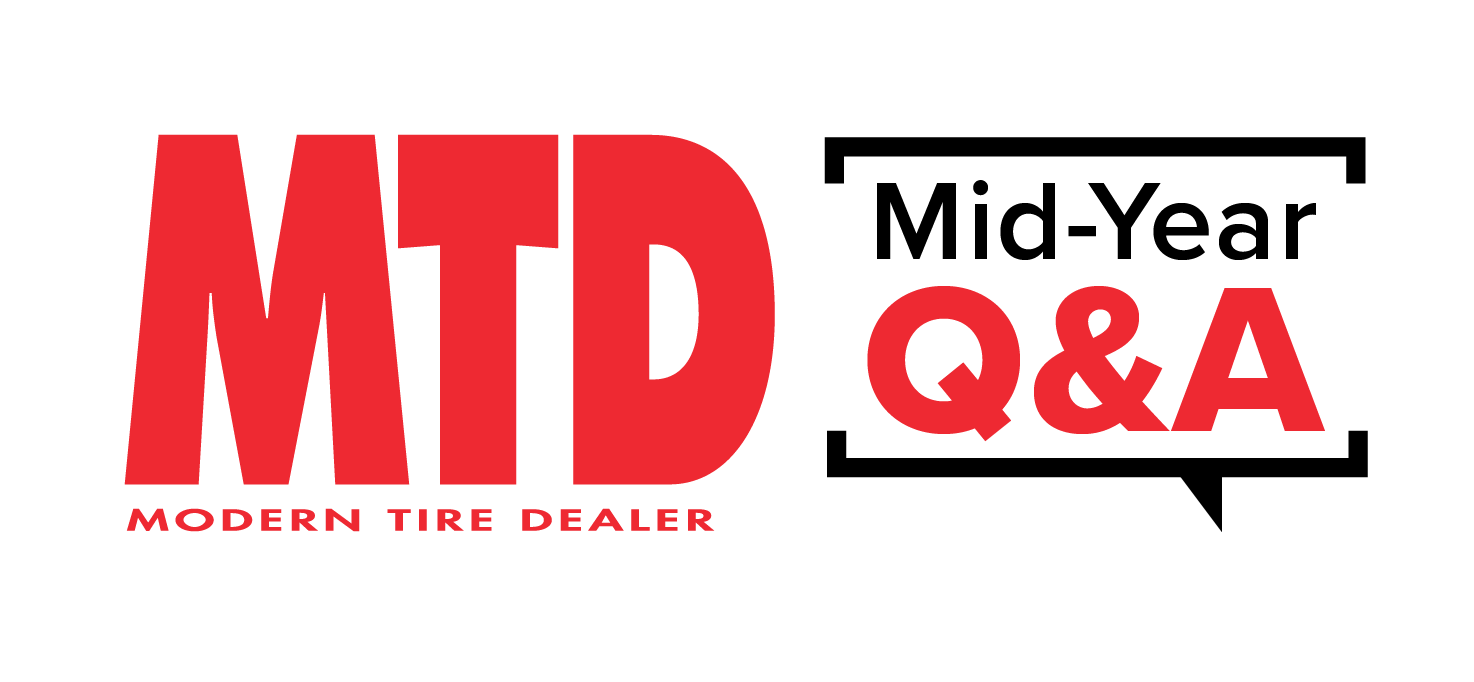In this MTD exclusive, Darren Thomas, president and CEO of Sumitomo Rubber North America Inc. (SRNA), discusses the company’s plans for its recently acquired Dunlop brand and more.
MTD: Can you bring us up to speed on SRNA's performance so far this year? What have some of SRNA's accomplishments and challenges been?
Thomas: I would say our first quarter business was stable. That is probably an accomplishment for us because we were the only tire manufacturer who took anticipated raw material price increases early in the first quarter to protect our global company from rising raws. We took that increase very thoughtfully and ultimately did what we thought was necessary. Despite those increases, our volume has remained stable because our relative price position in any given segment did not materially change. Maybe the index price went up a couple of percentage points, but it didn’t take us to a different category.
I would say we’re not trying to reinvent our business model. Our goal has been a steady progression of business in the face of uncertainty and distribution challenges, notably the ATD (American Tire Distributors Inc.) bankruptcy. What SRNA did that was exemplary was to maintain our relationship with ATD because of our long-term relationship and fit they have in the marketplace. We were able to grow our business while we worked through a collaborative agreement with ATD during a period when we didn't ship to them for 90 days. Our other distributors not only picked up that volume, but they grew their business. We were able to navigate a successful reconciliation with ATD.
The other bright spot is that although a painful disruption of our distribution channel, it gave not only SRNA but our other distributors an opportunity to reevaluate our strategy in the marketplace and reassess best ways to attack the independent dealer channel. ATD makes up between 20% and 40% of our associate dealer relationships. When something like that gets disrupted, that is a substantial challenge - not only for the manufacturer, but it also becomes an opportunity for other distributors. It also increases ATD’s need to highly service those dealers, all of which improves the service and value to the dealer. SRNA does want to acknowledge that these distribution challenges have had a notable negative effect on our distributors’ margins. Thankfully, we do believe this is simply a short-term matter.
MTD: What's your take on the state of both the consumer and TBR tire segment in the U.S. at the moment? What's demand like right now? What are you hearing from your customers?
Thomas: I would say demand through distributors is up because they are buying ahead of tariff price increases. Demand through carriers is stable. So it’s too early to give an indication of whether there's any trouble that's materially coming down the pike.
MTD: Now that SRNA's parent company, Sumitomo Rubber Industries Inc. (SRI), owns the Dunlop brand, how will SRNA position Dunlop in North America in relation to the Falken brand? What potential do you see in – or for - the Dunlop brand in the North American market, both in the short-term and the long-term?
Thomas: I would first recommend that the North American marketplace make an assessment of the efforts SRNA has put into developing the Falken brand and then ask themselves what level of effort they think we’ll put into the development of Dunlop brand. This will be a two-phase strategy for us, simply because of the condition of the Dunlop brand in North America and the timeline it takes to develop products for North American sales.
In terms of what we are starting with, in the European market, there’s still some reasonable business. In North America, that is anemic or non-existent. For North America, SRI has purchased blue sky and frankly speaking, SRNA would rather have a condition where we’re starting with a clean slate than starting with a line that’s obscure in the marketplace completely.
We are in the middle of finalizing our product plans for all segments of Dunlop through 2030 and we are beginning phase two of our product strategy for Dunlop for 2030 and beyond. These will be the types of products Dunlop needs to be a leader in the marketplace. The products we will introduce between 2026 and 2030 will be more value products to position Dunlop with distributors and retailers - passenger, light truck and TBR.
How that affects the Falken brand is a strategy we are working on now because as a global company, it’s going to take a mammoth effort to develop products for not only Europe, but North America. That’s a significant incremental global requirement for our company. We’re entertaining and considering all possible strategies to maintain Falken’s continued development and production, whether that be with our own parent company or others.
MTD: How will you position Dunlop in relation to Falken?
Thomas: I would encourage the marketplace to change their mindset about how we plan to position Falken in relation to Dunlop because they are non-competitive brands. The question is, 'Who can Dunlop compete with at retail or wholesale?’ Any educated retailer or wholesaler will recognize that existing brand recognition for Dunlop is still substantial, so the potential exists to sell Dunlop at premium price zones – for example (at the level of) Bridgestone, Continental and Goodyear.
We believe in the first generation, the Dunlop brand will offer massive margin potential for retailers who are willing to sell Dunlop at a premium price. At wholesale, then it becomes a slightly different strategy, but not entirely different. Wholesale will be driven mostly by how our new associate dealer program is coordinated.
MTD: There will be a new associate dealer program for Dunlop?
Thomas: We’re going to create a new associate Dunlop program that incorporates Dunlop, Falken, potentially Sumitomo and we may coordinate with distributors so their tier-four products of choice may qualify for this program.
MTD: Will this replace the Falken Fanatic program?
Thomas: It will replace Falken Fanatic.
MTD: When will the new dealer program roll out?
Thomas: The name and strategy details are still in process. However, the fundamentals of the program are in place. It may very well be inclusive of our TBR brands, also.
MTD: SRI closed its consumer and TBR tire plant in Buffalo in late-2024. Where did that production go? Was it transferred overseas or was the Buffalo plant's production/capacity simply removed from SRI's manufacturing footprint?
Thomas: At the same time we closed Buffalo, we finished expansions not only in the Japan market, but also (at SRI’s plant) in Thailand. We are net neutral in overall capacity, even after losing Buffalo. What changed for us is our TBR capacity. SRNA will simply consume a higher percent of SRI’s TBR capacity. We’ll actually increase allocation of SRI’s global capacity to North America as a result the Buffalo plant’s closure.
MTD: What impact will the new tariffs have on SRNA's sourcing and/or manufacturing strategy?
Thomas: I would say at the moment, everyone has to consider whether or not more domestic manufacturing is the right decision. That needs to be a thoughtful analysis, considering much of the cost of tires is raw materials, which, no matter the tariff, are going to be an imported good. Therefore, domestic manufacturing for the tire industry in North America is only a net gain, potentially, as it pertains to reduced shipping and elimination of tariffs, particularly the cost of labor. So we’ll say that a Section 232 tariff on an automobile tire may not be substantial enough to compel a manufacturer to bring domestic capacity to North America, simply because even domestic capacity will incur tariff-related costs. Furthermore, the average consumer is not buying tires every day. The average consumer will buy a tire every three or four years. Generally speaking, purchases made with that much time in between are not substantially affected by a 10% change in retail price. It’s a one-time purchase spread out over 36 to 48 months.
If tariffs become reciprocal – and reciprocal tariffs go into effect and are somehow additive to the (Section) 232 tariffs - all manufacturers would have to reconsider North American sourcing. In parallel, if only Section 232 tariffs have been implemented, which they have, and reciprocal tariffs stay at 10%, we do not see that having a material effect on the overall economy. If both go into effect, we should brace ourselves for a massive and substantial slowdown. A Section 232 tariff by itself is negligible; 232 plus reciprocal would be substantive.
MTD: How is ongoing consolidation among large tire distributors and dealers affecting SRNA?
Thomas: It's only affected SRNA in terms of credit exposure because of the consistency of consolidation being related to private equity ownership. It’s not a demand effect. The consumer needs tires, regardless of which distributors and retailers consolidate. It will be potentially an effect on mix, but mix is primarily affected by the availability of tier-three and tier-four products. Mostly the issue is credit risk. Generally speaking, there's more credit risk related to private equity ownership and less risk related to private ownership.
MTD: Can we expect to see new Falken-brand products from SRNA in 2025 and/or extensions of existing lines and product ranges?
Thomas: I would say the market should anticipate we will continue to expand and develop our LT, all-weather and medium truck tire offerings in the Falken brand. Those will not be affected whatsoever by the parallel development of new Dunlop products. People can count on the Falken brand to be available and heavily invested in, while we apply similar or increased efforts to Dunlop. The goal is not to reduce the emphasis on something that’s been successful. Our goal is to double down on what's been successful, while making every investment and effort possible to ensure that Dunlop is successful.
MTD: What can we expect to see from SRNA during the rest of the year?
Thomas: I think the marketplace should expect to have an increased amount of engagement with our management team while we thoughtfully consider all the elements related to our strategy in North America. It would be a mistake to assume that the Dunlop distribution model will mirror the Falken distribution model. Our goal is to make sure that we share our strategies, although possibly controversial and unorthodox, with the marketplace.
About the Author
Mike Manges
Editor
Mike Manges is Modern Tire Dealer’s editor. A 28-year tire industry veteran, he is a three-time International Automotive Media Association Award winner, holds a Gold Award from the Association of Automotive Publication Editors and was named a finalist for the prestigious Jesse H. Neal Award, the Pulitzer Prize of business-to-business media, in 2024. He also was named Endeavor Business Media's Editor of the Year in 2024. Mike has traveled the world in pursuit of stories that will help independent tire dealers move their businesses forward. Before rejoining MTD in 2019, he held corporate communications positions at two Fortune 500 companies and served as MTD’s senior editor from 2000 to 2010.


